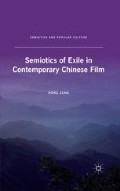Abstract
Chapter 3 examines the symbol of female doubling as the semiotics of postcolonial exile. Doubling indicates the separation within selfhood. The proliferation of the doubling image in modern literature and film is linked with the fragmentation and longing for companionship that is concurrent with the technological development of mechanical duplication and people’s increasing isolation, which accompany the advancement of modernity. Since in colonial discourse, the disempowered colonized is often feminized, female doubling emblemizes the split allegiance and complex identity of the colonized, and thus figures colonial and postcolonial exile. Such is the case in Chinese Box. The cinematic doubling of a Shanghai and Hong Kong actress in Center Stage brings Hong Kong and Shanghai into a mirroring relationship, in which fallen women are employed to figure fallen cities in colonial and postcolonial crisis. The cinematic doubling in Good Men, Good Women suggests the uprooted life of the contemporary Taiwanese that has lost the spiritual heritage of their forefathers, who were unsettled on their own land by the “white terror” of the Kuomintang government. In Farewell, China, schizophrenia is another form of doubling that internalizes the Diasporic cultural conflicts within selfhood.
Access this chapter
Tax calculation will be finalised at checkout
Purchases are for personal use only
Preview
Unable to display preview. Download preview PDF.
Notes
Laura Mulvey, “Visual Pleasure and Narrative Cinema,” Screen 16, no. 3 (Autumn 1975): 6–18.
See Mikhail Bakhtin, The Dialogical Imagination, trans. Michael Holquist (Austin: University of Texas Press, 1985).
Chris Berry, ed., Chinese Films in Focus II, 2nd ed. (London: British Film Institute, 2008) 49.
Ackbar Abbas, “Cosmopolitan De-scriptions: Shanghai and Hong Kong,” in Cosmopolitanism, edited by Carol Breckenridge, Sheldon Pollock, and Homi Bhabha (Durham: Duke University Press, 2002) 217.
See Abbas, Hong Kong: Culture of Disappearance (Minneapolis: University of Minnesota Press, 1997).
Mary Doane, The Desire to Desire (Bloomington: Indiana University Press, 1987).
Shelden Lu, ed., Chinese Language Film (Hawaii: University of Hawaii Press, 2004) 312–329.
Oscar Hingkay Ho and Matthew Turner, Hong Kong Sixties: Designing Identities, Hong Kong: Hong Kong Arts Center, 1994 13–19.
June Yip, “Constructing a Nation: Taiwanese History and the Films of Hou Hsiao-hsien,” in Traditional Chinese Cinema, ed. Sheldon Lu (Hawaii: Hawaii University Press, 1997).
Christine Metz, Film Language: A Semiotics of the Cinema (New York: Oxford University Press, 1971), 127.
Hou, Hsiao-hsien, Hou Hsiao-hsien dianying jiangzuo [Hou Hsiao-hsien master class]. (Guangxi: guangxi shifan daxue chubanshe, 2009), 26.
Jean-Francois Lyotard, Instructions Paiennes (Paris: Galilee, 1977), 39.
Dirlik, Arif and Xudong Zhang, eds. Introduction to Postmodernism and China. (Durham: Duke University Press, 2000), 178.
See Jerome Sibergeld, Hitchcock with a Chinese Face (Seattle: University of Washington Press, 2004).
Hillel Schwartz, The Culture of the Copy (New York: Zone, 1996), 24.
Zhang Zheng, Urban Generation: Chinese Cinema and Society at the Turn of the Twenty-First Century (Durham: Duke University Press, 2007), 353.
Bertolt Brecht, Brecht on Theatre, translated by John Willett (New York: Hill & Wang, 1964).
Peter Wollen, Signs and Meanings in the Cinema (Bloomington: Indiana University Press, 1969), 46–63.
Zhang Xudong, Postsocialism and Cultural Politics (Durham: Duke University Press, 2008), 181–222.
Anyi Wang. Chang Hen Ge [The Song of Everlasting Sorrow: A Novel of Shanghai] (Beijing: Zuojia chubanshe, 1996).
Shi Sumei, The Lure of the Modern: Writing Modernism in Semicolonial China, 1917–1937, Berkeley Series in Interdisciplinary Studies of China (Berkeley: University of California Press, 2001), 360.
Copyright information
© 2012 Hong Zeng
About this chapter
Cite this chapter
Zeng, H. (2012). Female Doubling and Postcolonial Exile. In: Semiotics of Exile in Contemporary Chinese Film. Semiotics and Popular Culture. Palgrave Macmillan, New York. https://doi.org/10.1057/9781137031631_4
Download citation
DOI: https://doi.org/10.1057/9781137031631_4
Publisher Name: Palgrave Macmillan, New York
Print ISBN: 978-1-349-43375-9
Online ISBN: 978-1-137-03163-1
eBook Packages: Palgrave Media & Culture CollectionLiterature, Cultural and Media Studies (R0)

